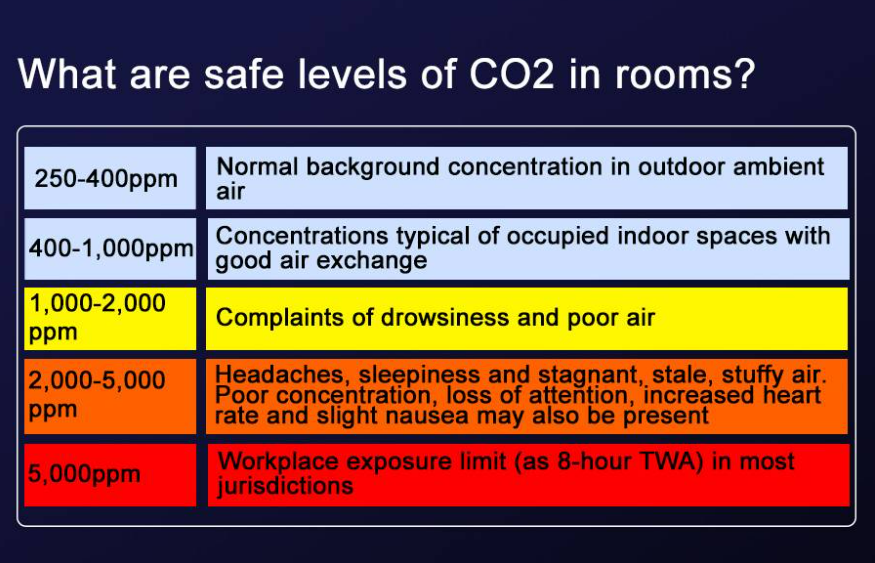Indoor air quality: how CO2 affects health and happiness at work
The #OQAI study found that indoor air is 5 to 7 times more contaminated than outdoor air. This is especially concerning because we spend between 80% and 90% of our waking hours indoors, especially at work. Numerous elements and contaminants, especially CO2, which is widely distributed in buildings, are to blame for the extremely filthy indoor air.
greenhouse gas CO2
With 77% of greenhouse gas1 (GHG) emissions, CO2 is the fourth most prevalent gas in the Earth’s atmosphere. In a normal concentration range, it is a harmless gas that has no color or smell.
Two different CO2 concentrations exist:
The quantity of CO2 produced by human activity:
mostly brought about by land use change and the usage of fossil fuels (oil, gas, and coal) (agriculture and deforestation). Additionally, it is created by the housing, industrial, and transportation sectors. As a result of these emissions, the amount of greenhouse gases in the atmosphere rises, which accelerates global warming.
Human activities, unlike human breathing, have no effect on the amount of CO2 that is exhaled into the atmosphere. Since CO2 content in indoor air is highly reliant on human occupancy and air renewal in the building or room, it is employed as a measure of the degree of air confinement.
What effect does indoor carbon dioxide have on people’s health?
According to ANSES, interior air in buildings typically has a carbon dioxide concentration between 350 and 2500 ppm.
The ANSES advises schools and other public areas to maintain a sufficient air renewal to stay under 1000 ppm. which is the air’s maximum allowable carbon dioxide concentration.
In fact, if the prescribed CO2 exposure levels are not followed, even a 1000 ppm dose is enough to cause negative impacts and may even have more severe health repercussions.

As shown in the table above, increased CO2 exposure has a negative impact on employees’ productivity and efficiency as well as their health. It demonstrated how controlled confinement and clean air might enhance cognitive function and lower absenteeism.
SARS-COV-2 and CO2
To stop the spread of COVID-19 in workplaces and public gathering places, it is now crucial to monitor the air quality of a space.
In order to ensure that the carbon dioxide level is acceptable, the HCSP (High Council for Public Health) and the Ministry of Labor have updated their version of the health protocol in workplaces and urged each company to measure the air quality.
In fact, recent expert recommendations from the HSCP and INRS state that one crucial component of preventive to lower the risk of transmission is the regulation of Indoor Air Quality (IAQ).
All indoor locations should have the lowest feasible CO2 levels to reduce the possibility of virus transmission through the air. The ideal range for outdoor CO2 concentration is between 400 and 800 parts per million. It is advised to leave the room and freshen the air if the threshold is surpassed.
How may the effects of CO2 and indoor air quality be improved?
The regulation mandates that business owners take into account the environment their patrons are in while making decisions. Concerning the quality of indoor air in workplaces is necessary to improve the working environment and have a positive impact on the Quality of Life at Work (QLW) in addition to adhering to the CSR policy (QWL).
There are numerous approaches to analyze the rate of CO2 in order to guarantee the health and comfort of people present in institutions, including businesses and schools:
To lessen the impacts of confinement, it is advised to open the windows and doors frequently.
Have good ventilation: To ensure good air renewal, a good ventilation system is advised.
limiting pollution sources: There are numerous sources of pollution, and it’s critical to keep them under control. Careful furniture selection, the use of “healthy” cleaning supplies, the isolation of photocopiers, etc. Here is further information.
Utilize air quality sensors to assess the amounts of carbon dioxide (CO2) and other contaminants in the space in order to make informed judgments and implement customized corrective actions.
GZAIR suggests using sensors to track information on the indoor air quality of buildings. These sensors allow for real-time monitoring of temperature, humidity, fine particles, and gases (CO2, VOCs).
These data can then be analized on GZAIR dashboard.
To preserve your resources and reduce dangers, we make the unseen visible, assuring the well-being of populations.

Leave A Comment